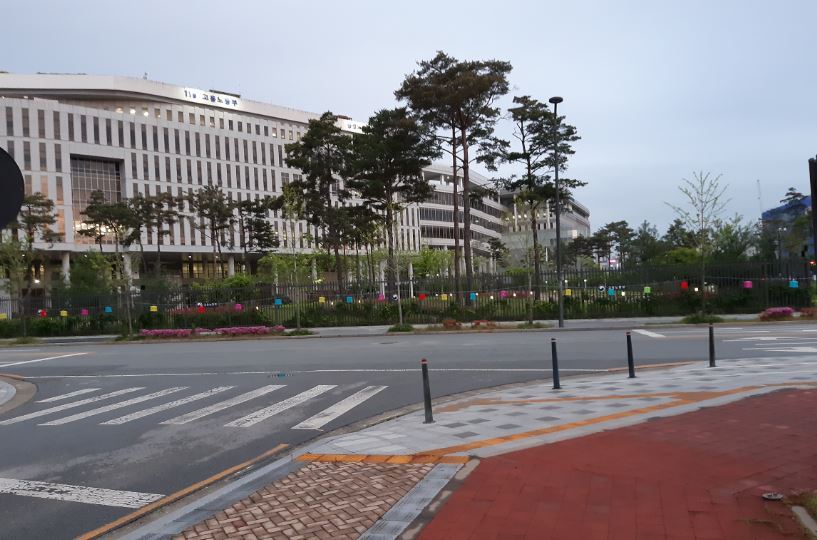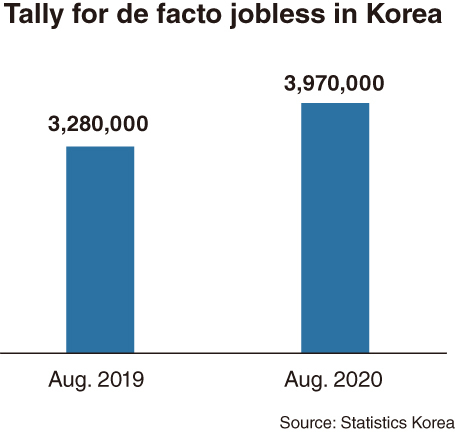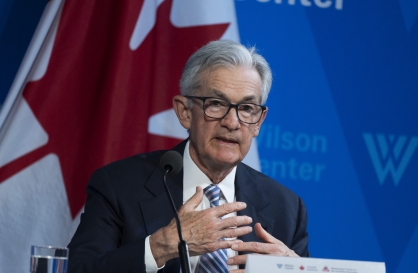[News Focus] No. of unemployed, underemployed up 20% from last year
By Kim Yon-sePublished : Oct. 11, 2020 - 17:24

SEJONG -- The hiring market in South Korea is still in the doldrums amid ongoing uncertainty in the wake of the novel coronavirus.
The number of unemployed plus underemployed came to 3.97 million people out of an economically active population of 29.9 million as of August, the latest period for which statistics were available from Statistics Korea. The “extended-based” (or de facto) jobless rate posted 13.3 percent, according to the statistics body’s Supplementary Index III for Employment.
This marked an increase of more than 20 percent -- 692,300 people -- from a year earlier. In August 2019 the tally of unemployed or underemployed people stood at 3.28 million out of an economically active population of 29.86 million, and the de facto jobless rate was 11 percent.
The Index III offers a relatively new method of calculating unemployment, counting underemployed people among the de facto unemployed. This category includes those who work fewer than 36 hours a week and want to work more, as well as seasonal workers who are out of work for part of the year.
Further, the situation is more critical for younger people, a great number of whom are said to have abandoned job-seeking amid the pandemic woes.
The number of unemployed plus underemployed came to 3.97 million people out of an economically active population of 29.9 million as of August, the latest period for which statistics were available from Statistics Korea. The “extended-based” (or de facto) jobless rate posted 13.3 percent, according to the statistics body’s Supplementary Index III for Employment.
This marked an increase of more than 20 percent -- 692,300 people -- from a year earlier. In August 2019 the tally of unemployed or underemployed people stood at 3.28 million out of an economically active population of 29.86 million, and the de facto jobless rate was 11 percent.
The Index III offers a relatively new method of calculating unemployment, counting underemployed people among the de facto unemployed. This category includes those who work fewer than 36 hours a week and want to work more, as well as seasonal workers who are out of work for part of the year.
Further, the situation is more critical for younger people, a great number of whom are said to have abandoned job-seeking amid the pandemic woes.

The extended jobless rate for those aged 15-29 -- the youngest group within the working-age population -- recorded 24.9 percent. The tally of unemployed plus underemployed people within the same age bracket reached 1.21 million in August, whereas the economically active population for that group was 4.86 million.
By comparison, in August 2019 those figures stood at 21.8 percent and 1.08 million people.
For people of all ages, the sectors hit hardest by the pandemic included airlines, tourism and private educational institutes, which have resorted to layoffs or hiring freezes.
According to the Ministry of Labor and Employment, the government paid out more than 1 trillion won ($867.6 million) in unemployment benefits for the fourth consecutive month in August. The monthly figure topped the 1 trillion won mark in May 2020, for the first time since the nation began compiling the data in 1995.
The situation is intensifying concerns about the state’s capacity to continue paying benefits at such high levels. Payouts had already seen a sharp increase even before the pandemic hit the nation, due to increases in the minimum wage and mass closures of small businesses over the past few years.
The amounts paid out in unemployment benefits have increased sharply on-year -- from 5 trillion won in 2017 to 6.43 trillion won in 2018, and to a record high of 8.07 trillion won in 2019.
The 2019 figure marked more than a 70 percent surge compared with 2016 under the previous administration, when it was 4.67 trillion won.
The increase in the minimum wage could affect these figures, because benefits are paid in proportion to a worker’s salary. But the data showed that the steep rise in benefits paid far outpaced inflation.
In August, recipients of unemployment benefits in their 50s made up the largest proportion of the total at 24.9 percent, the data from the Korea Employment Information Service showed.
Those in their 60s were next at 22 percent, followed by those in their 40s at 19 percent, those in their 30s at 17.8 percent and those in their 20s at 15.3 percent.
Women outnumbered men among benefit claimants in August, accounting for 51.7 percent of the total.
By Kim Yon-se (kys@heraldcorp.com)










![[Today’s K-pop] BTS pop-up event to come to Seoul](http://res.heraldm.com/phpwas/restmb_idxmake.php?idx=644&simg=/content/image/2024/04/17/20240417050734_0.jpg&u=)
![[Graphic News] More Koreans say they plan long-distance trips this year](http://res.heraldm.com/phpwas/restmb_idxmake.php?idx=644&simg=/content/image/2024/04/17/20240417050828_0.gif&u=)





![[KH Explains] Hyundai's full hybrid edge to pay off amid slow transition to pure EVs](http://res.heraldm.com/phpwas/restmb_idxmake.php?idx=652&simg=/content/image/2024/04/18/20240418050645_0.jpg&u=20240419100350)

